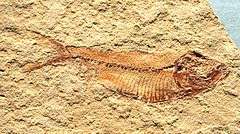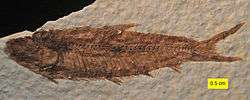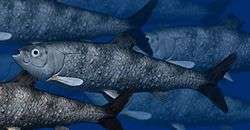Knightia
| Knightia Temporal range: Early Eocene | |
|---|---|
 | |
| Knightia alta specimen | |
| Scientific classification | |
| Kingdom: | Animalia |
| Phylum: | Chordata |
| Class: | Actinopterygii |
| Order: | Clupeiformes |
| Family: | Clupeidae |
| Subfamily: | Pellonulinae |
| Genus: | Knightia Jordan 1907 |
| Type species | |
| Knightia eocaena Jordan, 1907 | |
| Species | |
| Synonyms | |
|
Clupea eocaena Jordan], 1907 | |
Knightia is an extinct genus of clupeid clupeiform bony fish that lived in the fresh water lakes and rivers of North America and Asia during the Eocene epoch. The genus was erected by David Starr Jordan in 1907, in honor of the late University of Wyoming professor Wilbur Clinton Knight, "an indefatigable student of the paleontology of the Rocky Mountains." [1] It is the state fossil of Wyoming,[2] and the most commonly excavated fossil fish in the world.[3]
Description
Knightia belongs to the same taxonomic family as herring and sardines, and resembled the former closely enough that both Knightia alta and Knightia eocaena were originally described as species of true herring in the genus Clupea.
Rows of dorsal and ventral scutes ran from the back of the head to the medial fins. They had heavy scales, and small conical teeth. Their size varied by species: Knightia eocaena was the longest, growing up to 25 centimeters (10 inches), though most specimens are no larger than 15 centimeters.[4] Knightia alta was shorter and relatively wider, with specimens averaging between 6 and 10 centimeters.[4]
Predators
A small schooling fish, Knightia made an abundant food source for larger Eocene predators. The Green River Formation has yielded many fossils of larger fish species preying on Knightia; specimens of Diplomystus, Lepisosteus, Amphiplaga, Mioplosus, Phareodus, Amia, and Astephus have all been found with Knightia in either their jaws or stomach.[5]
Diet
As with modern-day clupeids, Knightia likely fed on algae and diatoms, as well as insects and the occasional smaller fish.[5]
Gallery
 Knightia eocaena from the Green River Formation (Eocene) of Wyoming.
Knightia eocaena from the Green River Formation (Eocene) of Wyoming. Artist's digital conception of Knightia sp.
Artist's digital conception of Knightia sp.- Slab of fossilized Knightia eocaena from Fossil Butte National Monument.
References
- ↑ Jordan, D. S. 1907. "The fossil fishes of California; with supplementary notes on other species of extinct fishes". Bulletin Department of Geology, University of California 5:136
- ↑ http://soswy.state.wy.us/SecretaryDesk/StateInfo_Symbols.aspx
- ↑ Kelley, Patricia H.; Kowalewski, Michał; Hansen, Thor A. (2003). Predator-prey interactions in the fossil record. ISBN 0-306-47489-1.
- 1 2 Grande, Lance (June 7, 1982). "A Revision of the Fossil Genus †Knightia, With a Description of a New Genus From the Green River Formation (Teleostei, Clupeidae)" (PDF). American Museum Novitates. ISSN 0003-0082. OCLC 47720325. Retrieved November 12, 2011.
- 1 2 Grande, L. 1980. The paleontology of the Green River Formation, with a review of the fish fauna. Wyoming Geol. Surv., Bull. 63, pp. 85.
| Wikispecies has information related to: Knightia |
| Wikimedia Commons has media related to Knightia. |